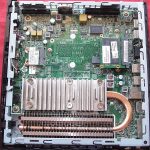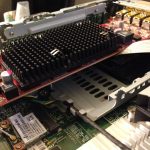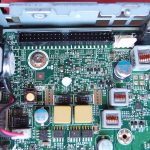I’ve been looking for something to replace the aging Asus O!Play HDP-R1.
While the media player still plays all my content, the usability is absolutely atrocious. It also doesn’t stream Netflix. Options included getting a Mac Mini for Plex or take a look at XBMC also has the advantage of being a live TV front-end for my HDhomerun and OTA system.
I’ve fooled around with XBMC for a bit and I still find the usability not to my liking, but it is much better than the O!Play.
Now that Netflix has gone HTML5 Video and provides Linux support on Chrome, it started to feel that XBMC was a viable alternative. Getting some ROMs and emulators going seemed intriguing for me as well.
I had planned to use my ESXI whitebox (AMD FX8350) to host XBMC and wire it from the basement to my TV.1 Unfortunately, fishing the cable proved more difficult and I was unwilling to make new holes in the ceiling of the basement, so I started looking for low power, stand-alone alternatives to host XBMC.
Since, I’m always looking at esoteric hardware, I was steered naturally to thin clients.
Enter the HP T610 Flexible Thin Client
Modern HP Thin clients are proving remarkably viable for this use case (although, as you’ll see below, I do have some reservations).
Older HP Thin clients, like the Atom N280-based T5740 require a Broadcom CrystalHD BCM970015 add-in card to sufficiently process 1080p video. However, the latest version of KODI “Helix” v14 (they changed their name from XBMC) has since dropped support for the CrystalHD, so I felt that this route wasn’t an ideal way to go.2 Since most modern graphic cards (GPUs) can natively decode HD video, looking for something that supported HD out of the box was a requirement.
Specs for the HP T610 flexible thin client
I picked up a used HP T610 Flexible Plus thin client from eBay for about $250 CAD shipping and taxes included.
The T610 is based on AMD’s Brazos architecture. It uses the G-T65N, a dual-core 1.65 GHz CPU w/ integrated HD 6320 GPU. The G-T65N is part of AMD’s embedded line of Fusion APUs. It is equivalent to their Zacate, line of chips. In fact, it shares the same specs as the AMD E-350 mobile processor.3 These chips were meant to compete with the Intel Atom D510 and D525 line. They provide slightly better performance on the processing side w/ a very large performance on the graphics.
| System features | |
|---|---|
| Processor | AMD Dual-Core T56N APU with Radeon HD 6320 Graphics 1.65 GHz |
| Operating system installed | Windows Embedded Standard 7 |
| Environmental | Low halogen |
| Browser supported | Microsoft Internet Explorer 9 |
| Standard memory | 4 GB 1600 MHz DDR3 SDRAM |
| 16 GB Flash (SATA DOM) | |
| Graphics | |
|---|---|
| Graphic card | AMD Radeon HD 6320 integrated AMD FirePro 2270 PCIe Video Card with 4 monitors support |
| Communication features | |
|---|---|
| Wireless | 802.11 a/b/g/n (Broadcom) |
| Network interface | 10/100/1000 (Broadcom) |
| Expansion features | |
|---|---|
| I/O ports | 1 DVI 1 Full-sized Display port (w/ Audio passthrough) 2 USB 3.0 4 USB 2.0 1 audio in 1 microphone in 1 headphone/line stereo output 1 RJ-45 2 PS/2 (keyboard & mouse) 2 DB9 serial 1 Parallel Port |
| Media devices | |
|---|---|
| Audio | Internal amplified speaker, 1/8-inch mini jack, full 16-bit stereo, 44-kHz sample rate, 1/8-inch mini jack microphone |
| Dimensions and Weight | |
|---|---|
| Product weight | 1.55 kg with stand |
| Dimensions (W x D x H) | 22 x 4 x 25.1 cm with stand |
The model that I got is pretty unique (C9K57UA#ABA) in that it is the “Plus” size version with the 4x PCIe riser and additional 4-way display card.4 I bought this because I figured I could always repurpose the thin client to make another pfsense router. The performance should be on par with an Intel Atom setup.
Some unique things about the board:
- Dual SATA ports – They overlap each other right angles.. You can reasonably mount a full drive in one, but you’d need some sort of msata-to-sata converter for the lower. If you are handy, you route cabling inside for a full-drive.
- 2 x USB3 ports – Nice to have.
- 2 x DB9 Serial ports – ?
- 1 x 25-pin Parallel port – WTF? Who needs that anymore?
- 1 x PATA / IDE connector – Probably for an MLC- NAND Flash Disk on Module (DOM)
Given that this is an embedded chip (soldered on), some of the features of the board are probably geared towards industrial use.
XBMC
The system comes pre-installed with Windows Embedded 7 Standard. It’s a stripped down version of Windows 7, but is only 32-bit. Thus, you don’t get full use of the 4GB of memory that is available. You can download a 64-bit version of Windows 8.0 from HP’s website. The device will self-activate. I chose not to meddle with the OS on the flash drive. I basically unlocked the drive from write-protect mode and updated the PC with the latest AMD Catalyst drivers and added XBMC “Gotham” v13.2. It ran pretty well using the built-in video card, but really struggled with some file formats that couldn’t be hardware accelerated at 1080p in Windows (things encoded with ffmpeg?). Even with hardware decoding, I was still seeing 65-85% CPU use. I also couldn’t get the system stable at all. Memtest86 found no errors, but running Prime95 would fail almost immediately. I suspected that this is Windows 7 Embedded not playing well.
Fortunately, I had a few spare video cards lying around and was able to add an old AMD HD 6450 card to the expanded chassis (fanless, supports all the hardware decoding and HDMI audio passthrough necessary). This card also does the de-interlacing necessary for any LiveTV setup in the future.
I also took the time to install XBMCBuntu over the Windows 7 Embedded solution. It flies with the new video card. Seeing 15-35% CPU utilization now when decoding 1080p.
Running at a solid 18W bursting to 30W.
Foiled by my TV
Up until then, I was working with the box connected to my computer LCD. Unfortunately, my old HDTV (an LG DLP with no HDMI) wouldn’t recognize the device. Not yet at least.
I shouted expletives at my TV.
So my experiment will probably mean much large purchase in the near future.
Final thoughts. Was it worth it?
I’ve been thinking about this for a while. While I’m able to get acceptable performance from the T610, it’s not without compromise (additional AMD HD6450 card).
Coincidentally, Kevin, also bought a similar thin-pc, the Lenovo q190 the same week I ordered the thin client. Their is a very large discussion thread about the Lenovo q190 — people basically call it the best HTPC for XBMC on the market right now. As of the time of this writing, it is still selling for $291 at Lenovo.ca w/ free shipping.
In hindsight, while I’m able to get acceptable performance off the thin client (there are many people who still use the E-350 as a platform for XBMC today), I’d go with the Lenovo hands down (even with the $100 dollar savings buying the thin client used). There are also more affordable routes to XBMC-like the multitude of cheap quad-core ARM/MAUI-based media players around.
Given that I can’t use the XBMC system until I solve the compatibility issues with my HDTV, I’ll proabably give PFSENSE a run on it.
- It sits unused in my basement. ↩
- There is an ongoing discussion for supporting the decoder chip via the Sam Nazarko’s OSMC derivative. So we might see support in future versions of KODI (there are a lot of Apple TVs that use this chip). ↩
- You can find much more information on the E-350 mobile line of processors. ↩
- Previous thin clients by HP, like the 5720 through to the 5740, had add on extensions chassis extenders which can be purchased at very little cost on eBay. However, it’s important to note that HP now uses separate model SKUs for this, so if you want to add an additional PCIe card, you need to get the “T610 Plus” version. ↩




Leave a Reply